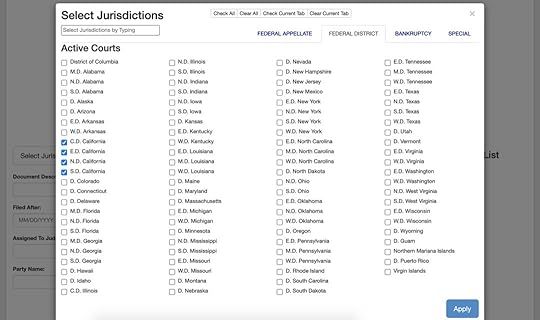Dominique Luchart's Blog, page 577
July 4, 2021
‘Last Ice Area’ in the Arctic may not survive climate change, ,

The “Last Ice Area,” an Arctic region known for its thick ice cover, may be more vulnerable to climate change than scientists suspected, a new study has found.
This frozen zone, which lies to the north of Greenland, earned its dramatic name because even though its ice grows and shrinks seasonally, much of the sea ice here was thought to be thick enough to persist through summer’s warmth.
But during the summer of 2020, the Wandel Sea in the eastern part of the Last Ice Area lost 50% of its overlying ice, bringing coverage there to its lowest since record-keeping began. In the new study, researchers found that weather conditions were driving the decline, but climate change made that possible by gradually thinning the area’s long-standing ice year after year. This hints that global warming may threaten the region more than prior climate models suggested.
Related: Images of melt: Earth’s vanishing ice
As climate change melts other regions of the Arctic, that could spell trouble for the animals that depend on sea ice for breeding, hunting and foraging, as the Last Ice Area “has been considered to be a refuge for ice-dependent species in a future ice-free summer Arctic,” said study co-author Kristin Laidre, a principal researcher at the Polar Science Center and an assistant professor in the University of Washington’s (UW) School of Aquatic and Fishery Sciences.
“If, as the paper shows, the area is changing faster than expected, it may not be the refuge we have been depending on,” Laidre told Live Science in an email.
The Last Ice Area spans more than 1,200 miles (2,000 kilometers), reaching from Greenland’s northern coast to the western part of the Canadian Arctic Archipelago. There, sea ice is typically at least 5 years old, measuring about 13 feet (4 meters) thick.
[image error]
The study looked at the Wandel Sea north of Greenland, which is inside what’s known as the “last ice area” of the Arctic Ocean. (Image credit: Schweiger et al./Communications Earth & Environment)In recent decades, ocean currents have bolstered ice cover in the Last Ice Area with chunks of floating sea ice. But researchers discovered that in 2020, northward winds transported ice away from Greenland and created stretches of open water that were warmed by the sun. The heated water then circulated under sea ice to drive even more melting, said lead study author Axel Schweiger, chair of UW’s Polar Science Center.
Polar scientists first suspected something might be amiss in the Last Ice Area in 2018, when a stretch of ice-ringed open water, known as a polynya, appeared in February, Schweiger told Live Science in an email. Then in 2020, Schweiger and his colleagues noticed another sea ice anomaly in the Wandel Sea while gathering data for an Arctic research expedition called The Multidisciplinary drifting Observatory for the Study of Arctic Climate (MOSAiC), which ran from September 2019 to October 2020.
As the scientists were developing a forecast for where the research vessel might drift, they noticed that the ship was taking “a strange-looking route” through areas that normally were covered in thick ice. “We started wondering what was happening and why, and whether it was potentially connected to what we saw in the 2018 event,” Schweiger said.
[image error]
This photo of sea ice on the Wandel Sea north of Greenland was taken Aug. 16, 2020, from the German icebreaker Polarstern, which passed through the area as part of the year-long MOSAiC Expedition. This area used to remain fully covered in ice throughout the year. Satellite images show that Aug. 14, 2020, was a record low sea ice concentration for this region, at 50%. (Image credit: Felix Linhardt/Kiel University)Satellite observations and climate models revealed that in 2020, unusual northward-moving winds broke up sea ice and pushed it away from the Wandel Sea. In fact, 2020’s record-low sea-ice cover would have been lower still if it hadn’t been for the thick ice that drifted into the area during that year’s winter months, Schweiger said.
These losses wouldn’t have been possible if climate change hadn’t already been chipping away at the Last Ice Area. Approximately 20% of the 2020 ice loss could be directly attributed to climate change, while 80% was linked to the wind and ocean-current anomalies, the researchers wrote.
RELATED CONTENT
—In photos: A conveyor belt for Arctic sea ice
—10 signs Earth’s climate is off the rails
—The reality of climate change: 10 myths busted
The lowest extents of Arctic ice cover have all taken place within the past 15 years, and climate projections suggest that summer sea ice everywhere in the Arctic except the Last Ice Area could vanish completely as soon as 2040. Last year, the National Snow and Ice Data Center (NSIDC) found that Arctic sea-ice minimum hit its second-lowest point of all time (after 2012), Live Science reported in Oct. 2020. And though the new study investigated only the Wandel Sea, the data hints that summer sea ice in the entire Last Ice Area may be at risk as well, the scientists said.
Ice loss is already affecting the Arctic animals that rely on it for survival, such as polar bears, ringed seals and bearded seals, “and sometimes narwhals and bowhead whales,” Laidre told Live Science.
While the new study doesn’t say if or when the Last Ice Area could melt completely, the trend of accelerated melt is expected to continue, Schweiger said.
“Given our results, we expect to see large patches of open water in this area more often,” he said. As to how that might affect marine wildlife, that too is difficult to predict, Laidre said.
The findings were published on July 1 in the journal Communications Earth and Environment.
Originally published on Live Science.
The post ‘Last Ice Area’ in the Arctic may not survive climate change, , appeared first on NEWDAWN Blog.
Most Americans think intelligent aliens exist, and half think they have visited Earth, ,

For the last few weeks, the imminent release of a U.S. intelligence report on unidentified flying objects (UFOs) had stirred excitement across the United States. So it’s not surprising to find that most Americans believe in intelligent life inhabiting other worlds, according to a survey conducted before the report was made public on June 25.
Approximately 65% of Americans concur that extraterrestrials exist, and about 51% say that UFO sightings reported by members of the U.S. military represent visits from intelligent aliens, according to a survey conducted by the Pew Research Center, a nonpartisan think tank in Washington, D.C.
Related: UFO watch: 8 times the government looked for flying saucers
Pew released their survey results prior to World UFO Day, an informal holiday celebrated on July 2 by UFO enthusiasts. The date is a nod to the purported 1947 UFO crash on a ranch at Roswell, New Mexico, according to the World UFO Day website. While the exact date of the alleged Roswell crash is unknown, the U.S. Army issued a press release on July 8, 1947, describing the recovery of a crashed flying disk from the ranch, launching an enduring fascination in the U.S. with extraterrestrials and UFOs (army representatives later identified the mysterious object as an errant weather balloon).
For the survey, Pew representatives questioned 10,417 American adults about aliens and UFOs. They found that about 76% of people between 18 and 29 years of age were likely to believe in intelligent aliens, compared with 69% of people ages 30 to 49 and only 58% of people ages 50 to 64. Regardless of age, most people who were surveyed — 87% — rejected the notion that UFOs posed a threat to national security — although the question didn’t break down whether that’s because they believe UFOs are ordinary objects or because they believe the aliens flying these UFOs are friendly.
The long-awaited government report on UFOs was promised to the U.S. Senate Intelligence Committee six months ago. The committee requested an investigation into unidentified aerial phenomena (UAPs), to be delivered by the the director of national intelligence and the secretary of defense, at a time no more than 180 days from Dec. 21, 2020 — the date when the Intelligence Authorization Act for the Fiscal Year 2021 was enacted.
RELATED CONTENT
—Greetings, Earthlings! 8 ways aliens could contact us
—9 strange, scientific excuses for why humans haven’t found aliens yet
—7 things most often mistaken for UFOs
While Pentagon officials released most of the new report, part of it remains classified and is not available to the public, Live Science previously reported. However, the report did reveal that military aviators recorded 144 UAP sightings between 2004 and 2021, of which only one could be definitively identified — as a weather balloon, the report said.
The report did not describe any UAPs as extraterrestrial in origin, instead saying “there are probably multiple types of UAP requiring different explanations based on the range of appearances and behaviors described in the available reporting.”
Originally published on Live Science.
Join our Space Forums to keep talking space on the latest missions, night sky and more! And if you have a news tip, correction or comment, let us know at: community@space.com.
The post Most Americans think intelligent aliens exist, and half think they have visited Earth, , appeared first on NEWDAWN Blog.
July 3, 2021
Watch the first trailer for the Star Wars: Visions anime anthology, Andrew Webster

At an Anime Expo Lite panel, LucasFilm revealed the very first look at Star Wars: Visions, an upcoming anthology of short anime films set in a galaxy far, far away. The sneak peek featured a huge range of visual styles and ideas, with shorts that featured, among many other things, a rock opera, a chibi Boba Fett, droids in straw hats, a twin Star Destroyer, and much more.
“We really wanted to give these creators a wide creative birth to explore the Star Wars galaxy,” LucasFilm executive producer James Waugh said during the panel. “We wanted this to be as authentic as possible to the studios and the creators. The idea was, this is their vision, riffing off all of the elements of the Star Wars galaxy that inspired them.”
The shorts announced at the event, and the studios working on them, include:
The Duel by Kamikaze Douga (Batman Ninja)Lop & Ocho by Geno Studio (Golden Kamuy)Tatooine Rhapsody by Studio Colorido (A Whisker Away)The Twins and The Elder by Trigger (Kill La Kill)The Village Bride by Kinema Citrus (Tokyo Magnitude 8.0)Akakiri and T0-B1 by Science Saru (Japan Sinks)The Ninth Jedi by Production IG (Ghost in the Shell)Visions was first announced last December, and is described as “an original series of animated short films” that “celebrates the Star Wars galaxy through the lens of the world’s best Japanese anime creators.” The anthology will be available on Disney Plus when it premieres on September 22nd.
Anime has become a big focus for streaming services, with both Netflix and Amazon Prime snapping up big-name titles. Visions will mark the first major anime series to debut on Disney Plus. That said, fan projects have clearly demonstrated in the past that Star Wars and anime are a good fit.
The post Watch the first trailer for the Star Wars: Visions anime anthology, Andrew Webster appeared first on NEWDAWN Blog.
Some accused in Capitol riot reportedly tried to scrub info from their phones and social media, Kim Lyons

Some 49 people accused of taking part in the January 6th riot at the US Capitol building have tried to erase images, videos, and texts from their phones and social media accounts, the Associated Press reported, citing a review of court records. Authorities told the AP that the people may have realized that the many photos and videos posted to social media by people participating in the riot could be used as evidence against them.
The AP cited several cases where accused rioters’ social media posts apparently contradicted what they told authorities about their involvement in the attack.
Hundreds of supporters of former President Trump stormed the Capitol building on January 6th as members of Congress prepared to certify the results of the presidential election. More than 500 people have been arrested in connection with the riot, Attorney General Merrick Garland said last month.
In the days following the attack, Sen. Mark Warner (D-Virginia), asked mobile carriers and social media platforms to preserve “content and associated metadata” that may have been connected to the attack.
The Washington Post reported Saturday that the Department of Justice has started arresting people who attacked reporters documenting the riot, damaging their equipment. The Post reports that the people would be charged with committing violence or destroying property on the grounds of the Capitol.
The post Some accused in Capitol riot reportedly tried to scrub info from their phones and social media, Kim Lyons appeared first on NEWDAWN Blog.
REvil ransomware attacks systems using Kaseya’s remote IT management software, Richard Lawler

Just in time to ruin the holiday weekend, ransomware attackers have apparently used Kaseya — a software platform designed to help manage IT services remotely — to deliver their payload. Sophos director and ethical hacker Mark Loman tweeted about the attack on Friday, and reported that affected systems will demand $44,999 to be unlocked. A note on Kaseya’s website implores customers to shut off their VSA servers for now “because one of the first things the attacker does is shutoff administrative access to the VSA.”
On Saturday, Kaseya issued another update, saying that it had been advised by its outside experts that “customers who experienced ransomware and receive a communication from the attackers should not click on any links – they may be weaponized.”
News Flash: cybercriminals are a$$holes.
Keep all the Incident Response teams in mind this holiday weekend as they’re in the thick of it…again.
If you use Kaseya VSA, shut it down *now* until told to reactivate and initiate IR. Here’s the binary: https://t.co/NIuGJZW84p https://t.co/GSXPlOPjFt
— Chris Krebs (@C_C_Krebs)
According to a report from Bleeping Computer, the attack targeted six large MSPs and has encrypted data for as many as 200 companies.
At DoublePulsar, Kevin Beaumont has posted more details about how the attack seems to work, with REvil ransomware arriving via a Kaseya update and using the platform’s administrative privileges to infect systems. Once the Managed Service Providers are infected, their systems can attack the clients that they provide remote IT services for (network management, system updates, and backups, among other things).
In a statement, Kaseya told The Verge that “We are investigating a potential attack against the VSA that indicates to have been limited to a small number of our on-premises customers only.” A notice claims that all of its cloud servers are now in “maintenance mode,” a move that the spokesperson said is being taken due to an “abundance of caution.” Later on Friday evening, Kaseya CEO Fred Voccola issued a statement saying they estimated the number of MSPs affected is fewer than 40, and are preparing a patch to mitigate the vulnerability.
“While our early indicators suggested that only a very small number of on-premises customers were affected, we took a conservative approach in shutting down the SaaS servers to ensure we protected our more than 36,000 customers to the best of our ability,” Voccola said in the statement, adding that the company’s SaaS customers were never at risk, and reiterating that “only a very small percentage of our customers were affected.”
On Saturday, Bloomberg reported that the attack was affecting more than 1,000 businesses in a ripple effect; the attack focused on managed service providers, but these providers offer IT services to other companies that may now be affected as well. A grocery chain in Sweden reported it couldn’t open 800 of its stores on Saturday when the attack resulted in its cash registers malfunctioning, Bloomberg reported.
The attack has been linked to the notorious REvil ransomware gang (already linked to attacks on Acer and meat supplier JBS earlier this year), and The Record notes that, collecting incidents under more than one name, this may be the third time Kaseya software has been a vector for their exploits.
Kaseya said Saturday it would provide updates on the situation every three to four hours.
Update July 2nd, 10:40PM ET: Added statement from Kaseya CEO.
Update July 3rd 12:04PM ET: Added new information from Kaseya and updates about the spread of the attack
The post REvil ransomware attacks systems using Kaseya’s remote IT management software, Richard Lawler appeared first on NEWDAWN Blog.
Dutch court rejects Facebook’s bid to have privacy lawsuit in the Netherlands dismissed, Kim Lyons

A court in Amsterdam ruled that privacy litigation against Facebook in the Netherlands can proceed, rejecting the social network’s bid to have the lawsuit from two non-profit groups thrown out.
As TechCrunch reported, the Amsterdam-based Data Privacy Foundation and Dutch consumer advocacy organization Consumentenbond are suing Facebook on behalf of users over what they claim are violations of European Union privacy law. The lawsuit says Facebook has not provided enough details about the information it gathers from users, including what it does with the data, and therefore doesn’t have a legal basis to process the information.
Facebook tried to block the lawsuit claiming that the Amsterdam court doesn’t have jurisdiction over its European business, which it argues is subject to Irish law. The Court of Amsterdam disagreed, writing in its decision that “The Data Privacy Foundation may litigate before the Dutch court on behalf of Dutch users of the Facebook service against Facebook about whether Facebook has violated the privacy of its users.”
A Facebook spokesperson said in a statement emailed to The Verge that it was reviewing the court’s decision, noting that the ruling was procedural, and that the company would continue to defend its position in court. “We care about our users in the Netherlands and protecting their privacy is important to us,” the spokesperson said. ” Users have meaningful control over the data that they share on Facebook and we provide transparency around how their data is used.”
Update July 3rd, 12:22PM ET: Adds statement from Facebook
The post Dutch court rejects Facebook’s bid to have privacy lawsuit in the Netherlands dismissed, Kim Lyons appeared first on NEWDAWN Blog.
How to find the documents behind big legal cases, Adi Robertson

Earlier this year, I spent a month covering the trial for a dispute between Apple and Epic. The case was one of the biggest antitrust suits in recent memory, and it brought to light revelations about both companies and the larger tech industry, often in the form of legal filings. I (and other reporters) try to pick out the most relevant details from these filings for readers. But sometimes, the documents are worth checking out in their own right. A site called CourtListener makes that easier than it might sound — if you know how to look.
US federal court documents are supposed to be publicly available through the Public Access to Court Electronic Records (PACER) system. But as somebody who frequently uses PACER, I can confirm it’s a really frustrating system. Signing up is a hassle, it costs 10 cents to run a search or retrieve a single page of a document, and all those charges add up quickly if you’re hunting down information about a case. PACER is basically a video game loot box mechanic for the legal system.
This limits access to resources that can help people understand US law and countless individual news reports better. (Some journalists re-upload and link filings via Scribd or DocumentCloud, but not every outlet follows this practice.) It also walls off a lot of stuff that’s simply interesting or funny. Want to read about FBI agents hunting a possibly mythical cache of gold stolen from the US Treasury during the Civil War by a secessionist secret society and then hidden in an underground cave network? The court system has you covered. Or take this recent ruling on the Federal Trade Commission’s case against Facebook, which may include the most portentous description of MySpace and Friendster ever written:
At the dawn of our century, in the much earlier days of the internet, a number of websites began to offer what came to be known as “social networking” services.
If you’d like that in the form of a Star Wars opening crawl:
Damn someone got there before me! pic.twitter.com/kKgwv5icl2
— No Context Paddy O’Connor (@paddypadman2)
Fortunately, there’s an unofficial PACER workaround. Maintained by the nonprofit Free Law Project, CourtListener hosts a free and open archive of millions of filings. It contains court opinions, audio of oral arguments from trials, and something called the RECAP archive — which is where you’ll find a lot of the most interesting material. That includes the long back-and-forth between Apple and Epic, government allegations like the cryptocurrency fraud claims against late antivirus tycoon John McAfee, and important legal decisions like a judge tossing the aforementioned Facebook antitrust suit.
The RECAP archive is a giant crowdsourced library based on a browser extension of the same name. When a user with the RECAP extension logs into PACER and downloads a document, a copy of it gets saved to the archive. Anybody can access it from there, whether or not they’ve got the extension installed.
RECAP is dependent on PACER users sharing a file, so you generally can’t get documents that nobody has looked up. But if you’re reading about a lawsuit or a big criminal case in the news, there’s a good chance you can find details in the archive. (One catch: PACER covers the federal court system, so if somebody was sued or charged at a state level, you’re probably out of luck.)
Navigating CourtListener can be a little overwhelming. On the RECAP archive, it’s helpful to search by the name of one of the parties involved, then narrow your search by district or state with the “select jurisdictions” filter. For instance, if you know a company was sued in California, you can select the four California districts under the “Federal Districts” tab. Sorting by “Newest Cases First” can be helpful for lawsuits and criminal charges that were just filed, and “Newest Documents First” can be good for cases that were just decided. If you have one document from a case already, you can look for the case number listed at the top of each page and search that as well.

When you click on a case, you’ll get its docket: a long record of everything that’s happened. Near the start of the list, you’ll probably find a complaint or indictment containing the allegations against the defendant in the case. You may also see a list of exhibits, or evidence like email chains or images. Further down you could find orders, where a judge hands down a decision. If these documents have been uploaded to the archive, you’ll see a link to download the file. If they haven’t, RECAP can direct you to PACER if you have an account — in which case this also is a great time to install RECAP and start uploading.
It’s important to remember that court documents are written for companies, individuals, and agencies with a specific agenda, and they don’t necessarily tell the full story of an event. (For example: the FBI did not find that hidden gold.) Interpreting them often requires background knowledge about specific terms and prior cases, although there are resources that can help, like writer and attorney Orin Kerr’s guide to reading a judge’s opinion. Even so, they’re a valuable tool for digging into some of the biggest stories The Verge covers — and sometimes a lot of fun.
The post How to find the documents behind big legal cases, Adi Robertson appeared first on NEWDAWN Blog.
The Verge’s favorite summer gear for 2021, Verge Staff

After over a year of indoor living, people are finally able to go out and enjoy the outdoors: beaches, sports, hiking, camping, bird-watching, bicycling, picnics… you name it. We asked some of our colleagues from The Verge what they were planning to take with them in their outdoor escapes. Here are some of their recommendations, including outdoor tech, camera gear, rugged footwear, and gadgets that help you take it easy.
Outdoor techTwelve months predominantly spent indoors did wonders for my battery anxiety. Not only was I using my phone less, thanks to having constant easy access to a tablet and laptop, but even when my phone got close to running out, my trusty charger was never far out of reach. However, I know that’s going to change this summer, and I’ll be confronted by the fact that my shiny new iPhone 12 Pro’s battery life really isn’t as great as I’d like it to be.
That means it’s time to bust out my ZMI QB820 PowerPack (more recently released as the ZMI PowerPack 20000), a hulking brick of a portable charger equipped with a massive 20,000mAh battery. Yes, I could probably get a slimmer model, but to me those feel like a half-measure: if I’m going to bother to carry a standalone portable charger, it might as well be massive. It charges over USB-C, and there are two additional USB-A ports to charge other devices.
It’s basically the last portable charger I see myself needing. Well, until someone makes an identical model with MagSafe, I guess. — Jon Porter

The ZMI PowerPack 20K sports a 20,000mAh capacity and features both USB Power Delivery 2.0 and Quick Charge 2.0 / 3.0 fast charging support.
$51
at ZMI
$60
at Amazon
For a while, I was resisting the urge to get a pair of fully wireless earbuds — I usually listen to podcasts or audiobooks when I’m walking around, and my old single-ear Plantronics Explorer 500 headset worked fine. But the idea of being able to sit outside on a summer’s day listening to music finally proved just too much for me, so I checked out The Verge‘s roundup of best wireless earbuds.
My main phone is an Android and in addition, I’ve put myself on a budget, so the top-rated AirPods Pro and Sony WF-1000XM4 were both out of range. I finally went for the Jabra Elite 75t earbuds — and so far, I’m very happy with them. They have good sound quality (especially after I tweaked the settings); they work with two devices at the same time, which I find very useful when I’m working on my laptop and somebody calls; and I was able to get a pretty good deal on them during Amazon’s Prime Day sales (especially since the 75t is one iteration down from the more recent 85t model).
Unfortunately, old habits are a bit hard to break, and I find myself, more often than not, only using a single earbud (the right one) as if I were still wearing my Plantronics headset. But for those times this summer that I want to listen to music, I’m set. — Barbara Krasnoff

Jabra’s Elite 75t earbuds offer pleasing bass-heavy sound, reliable performance, and can connect with two devices — like a phone and laptop — at the same time.
$135
at Best Buy
$135
at Amazon
For the longest time, my go-to portable speaker for camping and backpacking was the UE Roll 2. It was small and efficient, but it didn’t mesh well with the rest of my audio setup, especially on those sweltering summer days when I barely made it beyond the confines of my own backyard.
This year, however, I splurged on the Sonos Roam. The rugged, pint-sized device is on the pricier side when compared to other Bluetooth speakers, but it produces solid sound for the size, offers wireless charging, and can automatically jump between my home Wi-Fi network and Bluetooth, a convenience I’ve come to appreciate when strapping the speaker to my bike and heading out the door.
And while I might not be able to fire off my usual quips at Alexa when I take it into the backcountry — the Roam only supports voice commands when connected to Wi-Fi — I certainly can still do it poolside with a drink in hand. — Brandon Widder

A truly portable Sonos speaker with a rugged design that can endure the elements.
Get out your cameraYears of daily bus commuting turned me into a person who needs their backpack to do everything — hold a laptop, water bottle, snacks, sundries, actual roller skates, you name it. As versatile as camera backpacks have become, I still can’t convince myself to buy a backpack that only has one job. The Camera Cube was invented for people like me.
If your camera kit is on the lighter and smaller side, then Topo’s camera cube is a fantastic way to turn all of your bags into camera bags. I’ve used it with a Topo hiking backpack on many a day hike, and I appreciate the drawstring closure that keeps my camera gear more secure inside the cube. It also fits into my non-hiking backpack and technically in my Madewell Transport Tote, though it’s usually too heavy to wear on my shoulder for very long.
It comes with removable foam dividers so you can divvy up the storage space for an extra lens or two, but I’ve found it’s also a handy way to store a bagged PB&J where it won’t get crushed on a long hike. The navy and yellow color option is also quite attractive. It’s a little too small for a big DSLR and a zoom lens, but it’s the perfect fit for my compact mirrorless kit, and a small victory in my quest to avoid uni-tasking backpacks. — Allison Johnson

The Camera Cube bag is designed to keep your camera and gear secure — and can handle a sandwich or two as well.
$59
at Amazon
$59
at Topo Designs
This low-tech classic camera has made some of my favorite photographing memories. It’s all plastic and has a fixed setting of 60mm f/8 using medium-format 120 film. The Holga has a cult following because of its price and the charm in the imperfections it creates. There is an artistry to taping the camera in different ways to block light leaks and other quirks, and the occasional softness from bowing film or the vignetting look is where Instagram got the look for its filters. — Amelia Holowaty Krales

This low-tech plastic camera has become a cult favorite for its interesting and unique images.
Easy livingI always have two to three drinks with me at any given time, and at some point in the last couple of years I became hyper-aware of the number of plastic bottles I was using just to drink pop or seltzer. (I’m from the Midwest — it’s pop not soda!) I tried to switch to glass bottles, but that got expensive. After much deliberation and a sorry attempt at trying to become a strictly water and coffee drinker, I decided to get a SodaStream.
I’ve only had the SodaStream Fizzi for a while, but I am so thrilled with it. I use it every day to make my own sodas and sparkling waters, and to add a little flair to homemade cocktails. There are a large variety of recipes online, but it’s more fun to get creative with different flavors. Lately, I’ve been using fresh peaches and some muddled mint from my herb garden for a fantastic refresher!
The SodaStream Fizzi does have a small learning curve and takes some experimentation to find the amount of bubbles that you like, but it’s a blast to use. — Kaitlin Hatton

SodaStream Fizzi Sparkling Water Maker
$77 $90 15% offMakes fresh sparkling water at the push of a button.
I bought a hammock last year, and I’m never going back to any other way of relaxing in a park over the summer. It’s super portable, super easy to set up, and perfect for just taking a lazy Sunday, reading a book, and watching the clouds roll by. — Chaim Gartenberg

These affordable, premium-made hammocks come as a complete package with everything you need to get that perfect hang.
$40
at Amazon
$38
at Walmart
$40
at Wise Owl Outfitters
Amazon’s Kindle Paperwhite e-reader is a great gadget that lets you read books outside without having to worry about things like lugging around a thousand-page tome or dealing with the potential of wet pages. The Paperwhite’s E Ink screen is very visible outdoors (unlike most phone screens, which can be harder to see in bright sunshine), and the newest Paperwhite is waterproof, meaning it should be able to safely handle a splash or even a brief dip in the pool. Happy reading. — Jay Peters

This latest generation of the Paperwhite e-reader is waterproof and includes a better display and improved battery life over previous iterations. (These are ad-supported.)
$130
at Amazon (8GB)
$160
at Amazon (32GB)
Summer walking
Yes, I am recommending a pair of sandals. I’m justifying them on this list as technology for your feet.
For years, my go-to summer footwear was $20 flip flops, but those usually broke by the end of the summer and I didn’t particularly enjoy walking around in them. I’ve only owned the Birkenstock Milano sandals for two months, but they’ve become my favorite pair of shoes I’ve ever owned.
After a week or so of breaking them in, they fit like a dream, and I’ve already taken them on many long walks. I can’t wait to use them during the summer weeks ahead. I went with the Milano style because of the strap on the back so that they would be better for extended adventures.
At $125, they’re certainly the most expensive pair of sandals I’ve ever purchased, but they have already proven their worth. — Jay Peters

The classic Milano sandal has a contoured cork / latex footbed that molds to your foot and distributes your body weight evenly for optimal support.
I invite you to click through and look at these Trapper-Keeper-ass shoes. Really, just get their vibe. I spent a lot of the pandemic hiking — hell, I even took up running — and these trail runners from Saucony are really, really good. They’re grippy on uncertain terrain without being too heavy or stiff, so whether I want to jog on some dirt or knock out a long hike, these are my go-tos. Obviously, the shoe that works best for you will vary based on your foot and gait and so on, but if you’re thinking of taking up hiking, trail runners are lighter than hiking boots and often more comfortable. Plus, you can wear some genuinely shocking neon. — Liz Lopatto

Saucony Peregrine 11 trail runners
With updated uppers, these shoes deliver an aggressive, responsive ride for moving fast over rugged terrain.
$120
at Amazon (women’s)
$120
at Amazon (men’s)
If you want to go hiking and, like me, find hiking boots unbearably uncomfortable (especially in the summertime), I can give these sandals from Bedrock Sandals two thumbs up for being ultra-comfortable and durable hiking shoes that will keep being comfortable even after a river crossing or five (and for being versatile enough to bike in and wear to the beach or grocery store). — Mitchell Clark

Cairn Pro II Adventure Sandals
These hiking sandals give you superior footing no matter where you wander.
$120
at Bedrock Sandals
The post The Verge’s favorite summer gear for 2021, Verge Staff appeared first on NEWDAWN Blog.
Bird plans a pilot program for electric wheelchair and mobility scooter rentals in NYC this summer, Kim Lyons

Scooter company Bird is partnering with mobility vehicle company Scootaround on a pilot program that will test accessible electric vehicle rentals in New York City this summer, the companies announced. A new button in Bird’s main app will let people with mobility issues choose one of three different models to rent, including three- and four-wheel scooters and the Whill Model Ci2 power wheelchair.
Once the rider chooses a vehicle, they pick a rental length between one and 14 days. Riders will get an in-person tutorial the day of their rental to ensure they’re comfortable using, charging, and storing the vehicle. Bird has a toll-free number for questions about the process.
“As micromobility options such as shared bikes and scooters continue to expand, we must ensure the benefits of these improved transportation networks be made as widely available as possible, including to persons with disabilities,” Kerry Renaud, CEO of Scootaround said in a statement.
New York State lifted its ban on electric scooters in 2020, and the city Department of Transportation announced Bird, Lime, and VeoRide would be part of its e-scooter pilot in the Bronx this summer.
Bird plans to roll out the partnership with Scootaround to more cities later this year, based on the results of the NYC pilot.
The post Bird plans a pilot program for electric wheelchair and mobility scooter rentals in NYC this summer, Kim Lyons appeared first on NEWDAWN Blog.
Enjoy these tech deals for your Fourth of July weekend, Cameron Faulkner

If you’re in the US, you might be prepping for some exciting Independence Day plans. Whatever you’re getting up to — whether it be drinks with close friends and family or fireworks, if it’s safe in your area — we’ve pulled together some tech deals we think are worth your while. Plenty of retailers and manufacturers are offering great discounts this weekend on a wide variety of tech, including phones, video games, handy travel accessories, and more.
Preowned games are B2G1 free at GameStopWhether you have a Nintendo Switch, PS5, Xbox Series X, or another platform, you can load up on games this weekend with GameStop’s latest promo. If you add three preowned games to your cart, you’ll receive the least expensive one for free at checkout.

A modern retelling of the 1997 PlayStation classic. This game is the first of a yet-unknown number of episodic installments retelling the story of Final Fantasy VII.
$25
at GameStop
Save $100 with Woot’s deal on a refurbished iPhone 12 Mini
Normally, the iPhone 12 Mini costs $699 new, but if you aren’t too picky, Woot is selling a refurbished version for $100 less. Better yet, the retailer says these are “Grade A” units, which means they won’t have anything more than minimal cosmetic wear. These work on GSM and CDMA carriers.

The iPhone 12 Mini is the smallest phone in Apple’s lineup and the best small phone you can get.
$699
at Apple
$599
at Woot (refurbished)
Flying soon? Grab a Bluetooth transmitter for $25 this weekend
If you’re planning some air travel in the near future, you might want to figure out an elegant way to connect your wireless headphones to in-flight entertainment. Twelve South’s AirFly Duo can connect to two headphones simultaneously, and this weekend it’s down to just $25.

The AirFly Duo Bluetooth transmitter and receiver features an integrated 3.5mm cord, long battery life, and can connect to two sets of headphones. It’s great for in-flight entertainment or for pairing Bluetooth headphones to your Nintendo Switch.
The post Enjoy these tech deals for your Fourth of July weekend, Cameron Faulkner appeared first on NEWDAWN Blog.



